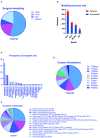Efficacy of acupuncture in animal models of vascular dementia: A systematic review and network meta-analysis
- PMID: 36062145
- PMCID: PMC9434110
- DOI: 10.3389/fnagi.2022.952181
Efficacy of acupuncture in animal models of vascular dementia: A systematic review and network meta-analysis
Abstract
Background and purpose: Acupuncture is widely used in clinical practice for the treatment of vascular diseases. However, the protocol, efficacy, and mechanism of acupuncture in animal models of vascular dementia are still controversial. Based on the above problems, we initiated this comprehensive study.
Methods: To analyze the literatures included in this study, 4 databases were searched and the SYRCLE's Risk of bias tool was employed. To perform the subgroup analysis of different acupuncture methods and the Review Manager 5.3 was applied. Meanwhile, the pairwise and network meta-analysis were conducted using Addis 1.16.8. The outcomes included escape latency, number of crossings, time spent in the target quadrant, and swimming speed.
Results: Forty-two studies with a total of 1,486 animals were included in this meta-analysis. According to the results from subgroup analysis, GV20 + ST36 (Baihui + bilateral Zusanli) combined with 14-day manual acupuncture can obtain best improvement of the rats cognitive function among all acupuncture regimens (MD: -23.41; 95%CI: -26.66, -20.15; I2 = 0%; P < 0.001). The heterogeneity of other acupuncture treatments was significantly higher than that of GV20 + ST36, because the treatment courses were not uniform. Pair-wise and network comparisons are highly consistent. The major results of the network meta-analysis were as follows, In comparison to the impaired group, the acupuncture group showed significantly reduced escape latency (MD: -25.87; 95%CI: -30.75, -21.12), increased number of original platform crossings (MD: 2.63; 95%CI: 1.94, 3.34) and time spent in the target quadrant (MD: 7.88; 95%CI: 4.25, 11.44). The overall results of the network meta-analysis are as follows: the normal and sham-operated groups performed the best, followed by medicine and acupuncture, while no effect was found in the impaired group treated with non-acupoint and palliative.
Conclusions: Acupuncture significantly improves cognitive function in rats with vascular dementia. Compared to other acupuncture plans, (GV20 + ST36, MA) and 14 -day manual acupuncture can be used to obtain better results. The main mechanism of acupuncture in the treatment of vascular dementia is reduced oxidative stress, neuronal inflammation, and apoptosis, as well as the increased synaptic plasticity and neurotransmitters.
Systematic review registration: https://inplasy.com/inplasy-2021-11-0036/, identifier: INPLASY2021110036.
Keywords: acupuncture; acupuncture mechanism; acupuncture protocol; animal studies; morris water maze; network meta-analysis; vascular dementia.
Copyright © 2022 Li, Shi, Zhang, Yang, Wan, Lv, Jian, Li and Li.
Conflict of interest statement
The authors declare that the research was conducted in the absence of any commercial or financial relationships that could be construed as a potential conflict of interest.
Figures




Similar articles
-
Manual acupuncture enhanced therapeutic efficacy in vascular dementia rat model: systematic review and network meta-analysis.Syst Rev. 2025 Apr 5;14(1):80. doi: 10.1186/s13643-025-02821-3. Syst Rev. 2025. PMID: 40186311 Free PMC article.
-
Can acupuncture reverse oxidative stress and neuroinflammatory damage in animal models of vascular dementia?: A preclinical systematic review and meta-analysis.Medicine (Baltimore). 2023 Jun 9;102(23):e33989. doi: 10.1097/MD.0000000000033989. Medicine (Baltimore). 2023. PMID: 37335660 Free PMC article.
-
[Acupuncture improves cognitive function of vascular dementia rats by regulating PI3K/Akt/mTOR pathway].Zhen Ci Yan Jiu. 2021 Oct 25;46(10):851-6. doi: 10.13702/j.1000-0607.200844. Zhen Ci Yan Jiu. 2021. PMID: 34698459 Chinese.
-
Effect of acupuncture on cognitive impairment induced by sleep deprivation in animal models: a preclinical systematic review and meta-analysis.Front Aging Neurosci. 2025 Mar 19;17:1560032. doi: 10.3389/fnagi.2025.1560032. eCollection 2025. Front Aging Neurosci. 2025. PMID: 40177248 Free PMC article.
-
Effects of acupuncture on vascular dementia (VD) animal models: a systematic review and meta-analysis.BMC Complement Altern Med. 2018 Nov 13;18(1):302. doi: 10.1186/s12906-018-2345-z. BMC Complement Altern Med. 2018. PMID: 30424749 Free PMC article.
Cited by
-
Exploring the effects of moxibustion on cognitive function in rats with multiple cerebral infarctions from the perspective of glial vascular unit repairing.Front Pharmacol. 2024 Oct 22;15:1428907. doi: 10.3389/fphar.2024.1428907. eCollection 2024. Front Pharmacol. 2024. PMID: 39508044 Free PMC article.
-
Manual acupuncture enhanced therapeutic efficacy in vascular dementia rat model: systematic review and network meta-analysis.Syst Rev. 2025 Apr 5;14(1):80. doi: 10.1186/s13643-025-02821-3. Syst Rev. 2025. PMID: 40186311 Free PMC article.
-
Resting-State fMRI Reveals the Neural Correlates of Acupuncture in the Treatment of Vascular Cognitive Impairment.Clin Interv Aging. 2025 Aug 8;20:1191-1204. doi: 10.2147/CIA.S529416. eCollection 2025. Clin Interv Aging. 2025. PMID: 40800108 Free PMC article. Review.
-
Can acupuncture reverse oxidative stress and neuroinflammatory damage in animal models of vascular dementia?: A preclinical systematic review and meta-analysis.Medicine (Baltimore). 2023 Jun 9;102(23):e33989. doi: 10.1097/MD.0000000000033989. Medicine (Baltimore). 2023. PMID: 37335660 Free PMC article.
-
The effect of acupuncture on oxidative stress in animal models of vascular dementia: a systematic review and meta-analysis.Syst Rev. 2024 Feb 8;13(1):59. doi: 10.1186/s13643-024-02463-x. Syst Rev. 2024. PMID: 38331921 Free PMC article.
References
-
- Bu Y., Li W. S., Lin J., Wei Y. W., Sun Q. Y., Zhu S. J., et al. . (2022). Electroacupuncture attenuates Immune-Inflammatory response in hippocampus of rats with vascular dementia by inhibiting TLR4/MyD88 signaling pathway. Chin. J. Integr. Med. 28, 153–161. 10.1007/s11655-021-3350-5 - DOI - PMC - PubMed
Publication types
LinkOut - more resources
Full Text Sources

